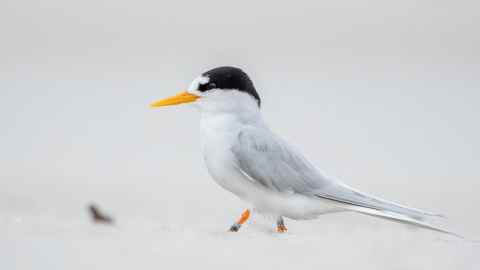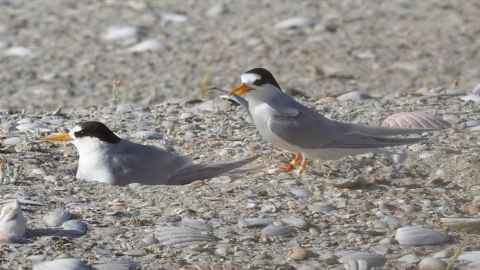Fighting for the future of New Zealand's rarest bird
13 June 2025
PhD student Nicole Whitelock is exploring strategies to safeguard the survival of the endemic tara iti.

On paper, the future of New Zealand’s smallest tern species, the tara iti, may look bleak. While once found on coasts throughout the North Island and in some eastern areas of the South Island, just 40 to 45 individuals remain, all in the upper North Island. A ‘Nationally Critical’ conservation status means this endemic species faces an immediate high risk of extinction.
Yet despite diminishing numbers, scientists at the University of Auckland are hopeful this unique and precious bird can be saved.
“Their English name is ‘fairy tern’, because they flit around like a little fairy,” says PhD student Nicole Whitelock. “They’re very small and relatively unassuming – you could probably walk past one without really noticing it – but when you watch them for a while, they have a really cheeky, interesting personality.”
Nicole is currently completing her PhD with support from The Shorebirds Trust, using computer-based solutions to determine effective methods for aiding the species’ recovery.
“My topic is looking at finding ways to enhance tara iti management to increase the population,” she explains.
Conservation has been a lifelong passion of Nicole’s, which she credits to a childhood spent in the great outdoors.
“I’ve always loved the outdoors. I grew up tramping with my dad and papa and spent a lot of time out in the ocean and on lakes. I’ve learned a lot about our native birds and fish. That was a big part of my life growing up, so to be able to move into a space where I can help is really important to me.”

Prior to her PhD she completed a Bachelor of Science in biology and psychology at the University in 2021, then a Master of Environmental Science in 2024, where she evaluated the distribution and abundance of native tuna (eels) in urban streams in across the Auckland region.
It was her Masters co-supervisor – and now PhD supervisor – Professor George Perry who recommended Nicole for a short-term research contract with the Department of Conservation (DOC). She jumped at the chance and, at the end of 2023, headed to Northland to gather data about a particularly rare bird: the tara iti.
“Breeding is restricted to four sites in Northland, with the main site at the Mangawhai sandspit. I was there observing the chicks, looking at how much they’re eating, how they’re progressing with their learning, how they’re foraging, observing any interactions they’re having with each other, with adult birds or birds of other species, to see if they are progressing like a wild chick would,” she says. “Tara iti are the rarest bird in New Zealand, so being able to spend that much time with them is really special.”
During her time with DOC she gained a clear understanding of the species’ biggest threats, which include habitat depletion, severe weather events and disturbance from recreational activities on beaches. Another major risk factor is predation from rats, cats, dogs and stoats, which prey on the vulnerable birds as they nest in shallow, exposed ‘scrapes’ in the sand.
To mitigate these threats, DOC workers cordon off nest sites, trap predators, employ sandbags for shelter and, in some instances, remove eggs for captive rearing. During the breeding season, which runs from October to February, full time rangers are also stationed on-site to monitor nests and educate the public.

Nicole hopes her research can build on these risk-mitigation strategies to improve management further. She began by reviewing literature and records to gather information about the tara iti and determine its historic distribution. She also drew on knowledge from volunteers and DOC workers familiar with the birds.
“I’ve been very lucky that there are a few people who have been working on tara iti since management began in the eighties,” she says. “Being able to talk to them and get their personal insights is invaluable.”
With this knowledge, she is building a species distribution model using computer coding to compare how the tara iti’s habitat has changed over time. Already she has found interesting results.
“I’ve built some maps showing what the historic distribution was versus what it is now, and there is a very evident decline in distribution,” she says. “By seeing where tara iti used to be, when the population grows or if birds need to be relocated, we can determine the best areas to move them.”
The Shorebirds Trust has been instrumental in enabling Nicole’s research to get underway by providing crucial funding and support.
“That is how this research is possible,” she says. “They are so supportive of what I do and interested in everything, which is really encouraging.”
If successful, her research could have a broader impact and potentially be applied to other endemic birds.
“The goal is to find the most effective ways to enhance tara iti numbers. Through that, hopefully some of the different models I build can be used for other species.”
Looking ahead, Nicole intends to remain on a conservation path, whether continuing with scientific research, working with an NGO or for a government organisation like DOC.
“I don’t know specifically what the future will look like, but staying within a conservation space is probably always going to be my focus. I really want to be helping species that need it.”
Media contact
Helen Borne | Communications and Marketing Manager
Alumni Relations and Development
Email: h.borne@auckland.ac.nz